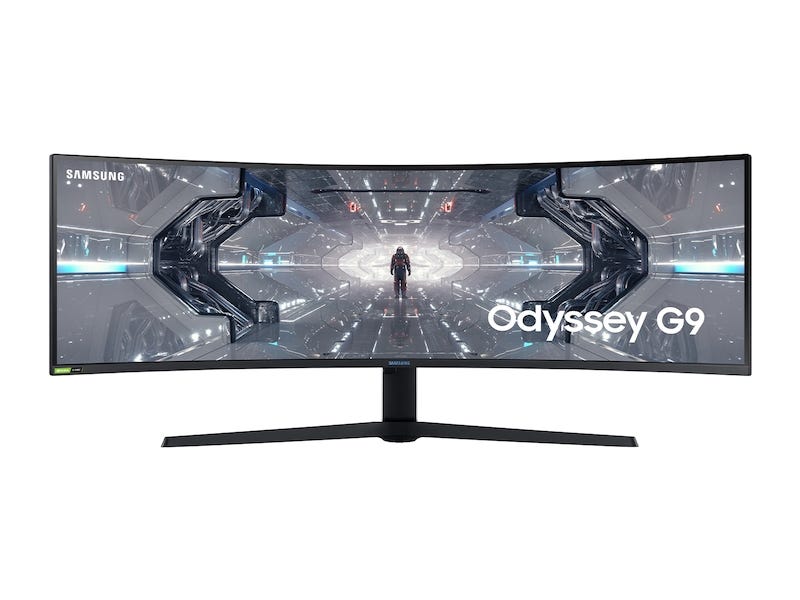A Great Monitor is Hard to Find
It’s been a long search to find the best monitor that fits both my gaming and work personas. There is no secret that I spend a lot of time at my desk, and having something that provides cutting edge connectivity like PBP (Picture-by-Picture) and Power Delivery via USB-C as well as a super fast response time of 1MS GTG (grey to grey) to prevent tearing when playing my favorite games was an absolute must. I’ve purchased, and returned, just about every high-end monitor available on Amazon trying to find the one that was just right. What I discovered may be surprising!
The text is either way too sharp, or way too blurry causing massive migraines and headaches
I personally cannot support 4K (4096x2160) or anything widescreen running at 1440p. The reason was simple: text is either way too sharp, or way too blurry causing massive migraines and headaches. What I needed was something right in between, which is where the UW-QHD form factor comes into play. At 3840x1600, I found the perfect balance between height and width, where the text was easier to view at 24" inches, and its ratio prevented on screen content from looking warped or skewed. Anything over 30" requires a curve to prevent neck strain and viewing angle issues.
What I Was Looking For
Here is a list of the features I needed vs thought it would be nice to have:
- Bigger than 34" would give more than enough screen real estate without needing more than one monitor
- Since it’s over 30", it would need to be curved for it to be comfortable to view
- Must support DisplayPort (preferred over HDMI)
- Must have a vertical resolution greater than 1440p
- Must support G-Sync for all the competitive gaming I take part in
- Refresh rate had to be >120Hz
- Response time had to be < 3ms GTG
Now the nice to haves were:
- Power Delivery via USB-C to prevent the need for a docking station in between the monitor and the computer
- Picture in Picture or Picture by Picture where the monitor renders two input sources in parallel
- VESA 100mmx100mm mounting capability
- No drivers or vendor software required
Samsung
All of the Samsung Odyssey monitors and the G series were immediately disqualified once I saw how terrible the 1440p resolution rendered the text. They worked great in game-only mode, when Fortnite or Call of Duty was the only app full-screened. However, once I had to switch to my coding editor, I was more than disappointed.

There is one notable exception when it came to Samsung, and that would be the U28H750UQ — where the physical size was just too small, the power draw was just a little too much, but it’s HDMI2 supports G-Sync compatibility mode and the text was super crisp.
LG
The same went for pretty much all of the UltraGear line by LG, each of which missed the mark. Inversely, the text looked great at 1440p for the majority of the monitors they offer, but gaming performance had a lot to be desired. Tearing and render lag caused significant GPU power draw, which led to rendering time lag and a poor gaming experience.
However, there were two large form factor monitors that did stick out, which were equally as large as the hole they would put in your wallet.
Narrowing It Down
At the end of the day, it came down to two monitors, the LG 38WN95C and the LG 38GL950G. They are both 38" ultra-wide monitors which support HDMI 2.0 and DisplayPort 1.2, both had 1ms response times, and they both sported a beautiful 21:9 UW-QHD resolution of 3840x1600. Where they started to differ was who they were targeted towards.
The 38WN95C was geared towards the working professional, where 94W of Power Delivery via USB-C was one of the huge selling points while still offering G-Sync Compatibility via AMD FreeSync. The bezel was small, and the back of the panel was white plastic. There were no LED’s and it was visually boring. It also supported the much loved PBP capability, support two side-by-side inputs displayed at the same time, WITHOUT any 3rd-party software.

The 38GL950G was targeted at gamers. It supported an overclock mode allowing me to reach upwards of 175Hz refresh rate, native G-Sync support, no USB-C and a black back panel with RGB LED’s to give it some style. Honestly, I could care less about the back mounted RGB’s. If anything, they just remind me that I forgot to turn the monitor off. Lastly, this display had stability issues if it was not in overclock mode where vertical interlacing was extremely noticeable, flickering occurred with dark content on the screen, and infrequent burn-in temporarily making the display unusable,
A Clear Winner
Long story short, the 38WN95C was the clear winner here. Despite it’s ugly panel not matching my office aesthetics, and the trading of G-Sync for AMD FreeSync, it’s performance still matched that of the 38GL950G, with the added benefit of Picture by Picture and Power Delivery via USB-C support. It removed my reliance on a 2-pc DisplayPort KVM from Level1 Techs and reduced my overall power draw in the office, and improved connectivity. With a combination of macOS Universal Control + Synergy for keyboard and mouse sharing, I can cast to my mac mini while playing games on my Windows machine, all on the same display.
The price tag is currently around $1,500, but with the amount of time spent in the office, that breaks down to less than $0.70/hour which is a benchmark I use when justifying cost.


Member discussion